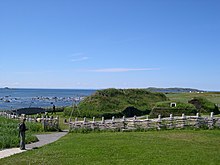
Western Newfoundland is part of the Canadian province of Newfoundland and Labrador, running along the western edge of the island of Newfoundland.
Towns and cities[edit]
- 1 Corner Brook — the largest city in Western Newfoundland, its port is an attraction for visiting cruise ships
- 2 Deer Lake — the closest major town to Gros Morne National Park, and home to the principal airport for western Newfoundland
- 3 Port au Port Peninsula — connected to the island by a narrow isthmus, it has a lively francophone community descended from French fisherfolk and Acadians
- 4 Port aux Basques — the main point of entry for Trans-Canada Highway traffic arriving by ferry from Cape Breton, Nova Scotia
- 5 Stephenville — home to Ernest Harmon U.S. Air Force from 1941 to 1966, the town uses many former USAF structures for housing, recreation and entertainment
Other destinations[edit]

- 1 Great Northern Peninsula — home to L'Anse aux Meadows National Historic Site, a former Viking settlement at the northern tip of the peninsula
- 2 Gros Morne National Park — a UNESCO World Heritage site, and an area of impressive natural beauty, rural Newfoundland culture, and unique geological wonders
Understand[edit]
As part of the 1763 Treaty of Paris, France ceded to Great Britain all of its territories in what is now Canada, except for the islands of St.-Pierre and Miquelon. The treaty gave France the right to continue fishing along the west coast of Newfoundland, a right it retained until 1904.
As a consequence, western Newfoundland developed much later than the rest of the island. Without access to the fish stocks of the area, the predominantly English and Irish Newfoundlanders had no reason to settle there, and the French fishers were not supposed to settle there. Some French did settle, and their descendants continue to live in French on the Port au Port Peninsula. While central and eastern Newfoundland towns have historic buildings, western Newfoundland buildings are mostly of 20th-century construction.
Get in[edit]
By air[edit]
- Deer Lake Regional Airport (YDF IATA) is the main gateway to the region with daily flights from Halifax, St. John's and Toronto year-round, and from Montreal in summer.
- Stephenville International Airport (YJT IATA) has weekly service from Toronto during the summer tourist season.
By boat[edit]
- Marine Atlantic operates car ferry service from North Sydney, Nova Scotia, to Port aux Basques.
By car[edit]
Deer Lake is 640 km west of St. John's on the Trans-Canada Highway.
By bus[edit]
DRL Coachlines and Newhook's Transportation offers scheduled passenger coach services from St. John's through Deer Lake to Port Aux Basques.
Get around[edit]
The Trans-Canada Highway (#1) will take you from Port aux Basques in the south to Deer Lake, and provincial highway 430 will take you up the Great Northern Peninsula to St. Anthony at the northern tip of the island.
Norpen Bus Service runs a shuttle from Deer Lake to St. Anthony (for L'Anse aux Meadows) on Tuesdays & Fridays.
See[edit]
Western Newfoundland's two UNESCO World Heritage Sites, Gros Morne National Park and L'Anse aux Meadows, are the main draws to this region.
Gros Morne is known for its fjord-like lakes, and ruggedly beautiful tablelands. The interpretation centre and recreated Viking village at L'Anse aux Meadows explain the history of the Europeans who settled there almost half a century before Christopher Columbus arrived in the Americas.
The Port au Port Peninsula provides a window into the culture of a French-speaking community that has been isolated for centuries.
Do[edit]
Gros Morne National Park offers 20 marked day-trip hiking trails and longer excursions. Boat trips on Western Brook Pond and Bonne Bay are easy ways to see the dramatic scenery of these faux fjords.
Eat[edit]
You can find moose (steaks, burgers) in some restaurants. Moose are an introduced species that are a bit of a nuisance, so their population is controlled through hunting. Moose meat is surprisingly rich and tasty.
With the local fishing industry, fresh seafood is available throughout this region. Lobster season is during spring (April-July) with restaurants in the area able to procure directly from the fisheries. Both saltwater fish such as cod and halibut and freshwater fish such as trout are a part of many menus.
Berry jams and pastries are produced in this region. Try pastries and jams of cloudberry (bakeapple) and partridgeberry, which are native to this area. You'll find that breakfast will usually come with a selection of these jams.
Drink[edit]
Stay safe[edit]
When driving, keep your eyes peeled for moose on the highways. Especially in the spring rutting season, moose will dart from the forest onto the highways. Car-moose crashes are frequent and are a serious cause of fatalities (human and moose). An encounter between a car and a 500-kg, 2-m-tall moose at high speed is something to be avoided.
Go next[edit]
- Take the ferry at Port-aux-Basques to North Sydney, Nova Scotia.
- Continue exploring the rest of the Newfoundland.

